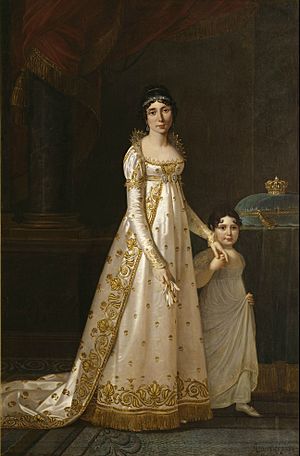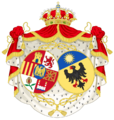Julie Clary facts for kids
Quick facts for kids Julie Clary |
|||||
|---|---|---|---|---|---|
| Comtesse de Survilliers | |||||

Portrait with her daughter Zénaïde by Robert Lefèvre, 1807
|
|||||
| Queen consort of Spain and the Indies | |||||
| Tenure | 8 June 1808 – 11 December 1813 | ||||
| Queen consort of Naples | |||||
| Tenure | 30 March 1806 – 6 June 1808 | ||||
| Born | Marie Julie Clary 26 December 1771 Marseille, Kingdom of France |
||||
| Died | 7 April 1845 (aged 73) Florence, Grand Duchy of Tuscany |
||||
| Burial | Santa Croce, Florence, Italy | ||||
| Spouse | |||||
| Issue |
|
||||
|
|||||
| House | Bonaparte (by marriage) | ||||
| Father | François Clary | ||||
| Mother | Françoise Rose Somis | ||||
| Religion | Roman Catholicism | ||||
Marie Julie Clary (born 26 December 1771 – died 7 April 1845) was a French noblewoman. She became the Queen of Naples and later the Queen of Spain. She was married to Joseph Bonaparte, who was the older brother of Emperor Napoleon Bonaparte.
Joseph Bonaparte ruled as King of Naples from 1806 to 1808. After that, he became King of Spain from 1808 to 1813. Julie Clary was his queen during these times.
Contents
Early Life and Family
Julie Clary was born in Marseille, France, on 26 December 1771. Her father was François Clary, a very rich silk maker and merchant. Her mother was Françoise Rose Somis.
Julie had a younger sister named Désirée Clary. Désirée later became the Queen of Sweden and Norway. This happened when her husband, Marshal Bernadotte, became King Charles XIV John of Sweden. Julie also had a brother, Nicolas Joseph Clary.
Marriage to Joseph Bonaparte
On 1 August 1794, Julie Clary married Joseph Bonaparte. Joseph was the older brother of the famous Napoleon Bonaparte. The wedding took place in a town called Cuges-les-Pins.
After their marriage, Julie went with Joseph to Italy in 1797. He was working there as an ambassador, which is like a country's representative. In 1804, they moved to Paris.
When Napoleon became Emperor in 1804, he made his brother Joseph an Imperial Prince. This meant Julie became an Imperial Princess too. During Napoleon's coronation ceremony, Julie helped carry the Empress's long dress.
Queen of Naples
In 1806, Napoleon made Joseph the King of Naples. This made Julie the queen of Naples. However, Julie preferred to live separately from Joseph. She stayed at her home in Mortefontaine, France. Even so, she was treated like a queen at Napoleon's court in Paris.
Julie finally joined Joseph in Naples in 1808. Napoleon had sent her there to support Joseph. At that time, Joseph was facing a rebellion in Naples.
Queen of Spain
In 1808, Joseph Bonaparte became the King of Spain. This meant Julie officially became the Queen of Spain. She was the first Spanish queen who was not born into a royal family.
However, Julie never actually lived in Spain. She chose to stay at her home in Mortefontaine, France. In France, she was seen as Joseph's representative. She was treated as the Queen of Spain at Napoleon's court.
Julie also acted as a messenger and informant for Joseph. She wrote letters to him about Napoleon's plans for Spain. She warned Joseph that he needed to control Spain's unity, money, and army himself. This was because Napoleon would not let Spain be too independent. In Spain, people called her "Reina ausente," which means 'The Absent Queen.'
The Fall of Napoleon
Napoleon's army was defeated in the Battle of Vitoria on 21 June 1813. During this war, Julie helped her sister Désirée Clary. Désirée was married to the Crown Prince of Sweden, which made her an enemy citizen. Julie also gave shelter to her sister-in-law, Catharina of Württemberg, at her home.
When the allied armies took Paris in 1814, Julie herself found safety at her sister Désirée's home. After Napoleon gave up his power in 1814, Julie bought a castle in Prangins, Switzerland.
In 1815, during the "Hundred Days" when Napoleon returned to power, Julie welcomed him. She wore a special court dress, just like his stepdaughter Hortense.
After the Battle of Waterloo in 1815, Napoleon was defeated again. Members of the Bonaparte family were sent away from France. Joseph bought land in New Jersey, in the United States. He used money from selling Spanish paintings that had been taken from palaces and monasteries.
Julie, however, did not go with him to America. She went to Frankfurt, Germany, with her daughters. She stayed there for six years, separated from her husband.
In 1816, her sister Désirée, who was now the Crown Princess of Sweden, wanted Julie to come live with her in Sweden. But Désirée's husband thought this was a bad idea. He worried that having a Bonaparte family member might make it seem like he supported the defeated Napoleon. So, Julie did not go to Sweden.
Later Life and Death
Julie moved to Brussels, Belgium, in 1821. Later, she settled in Florence, Italy, at the Palazzo Serristori. She did not spend much time with other French people there. People described her as charming, quiet, and dignified. She was generally well-liked. In 1823, her sister Désirée became the Queen of Sweden.
In 1840, Joseph Bonaparte joined Julie in Florence. Joseph died on 28 July 1844. Julie died eight months later, on 7 April 1845, in Florence. She was 73 years old.
They were both buried in the Basilica of Santa Croce in Florence. In 1862, Napoleon III, who was a French Emperor, brought Joseph Bonaparte's remains back to France. Joseph was reburied next to his younger brother, Emperor Napoleon I. Julie's remains are still in Florence, next to her daughter Charlotte. Charlotte died in Italy in 1839 at age 36.
Children
Joseph and Julie Bonaparte had three daughters:
- Julie Joséphine Bonaparte (born 1796)
- Zénaïde Laetitia Julie Bonaparte (1801–1854), who had twelve children.
- Charlotte Napoléone Bonaparte (1802–1839). She married Napoléon Louis in 1826. He was the oldest son of Louis Bonaparte, King of Holland.
Images for kids
See also
 In Spanish: Julia Clary para niños
In Spanish: Julia Clary para niños


